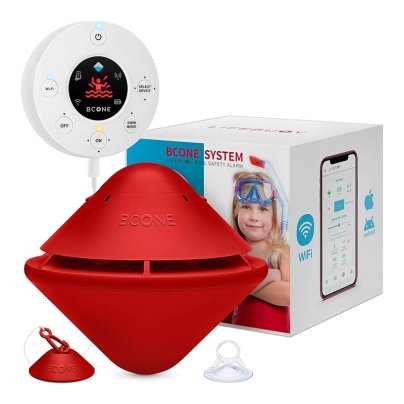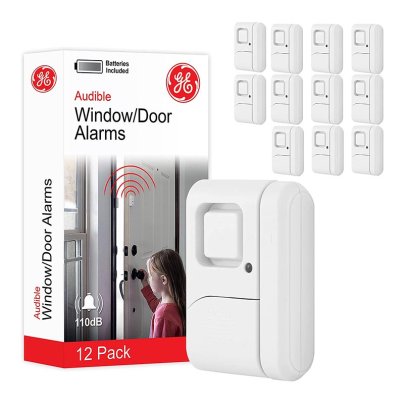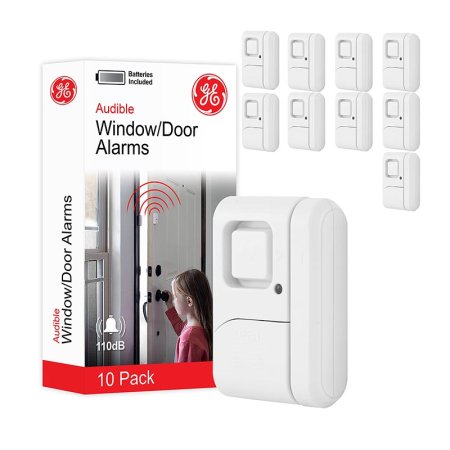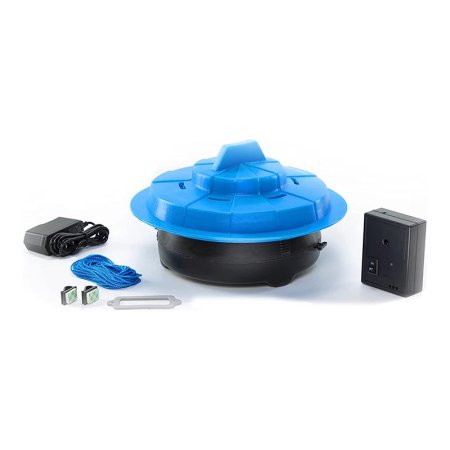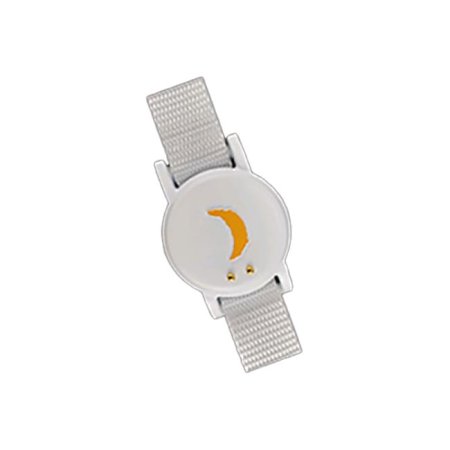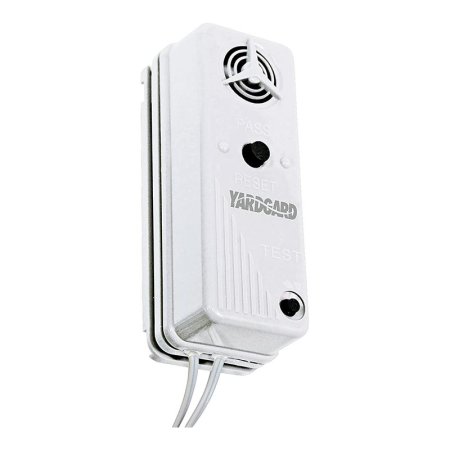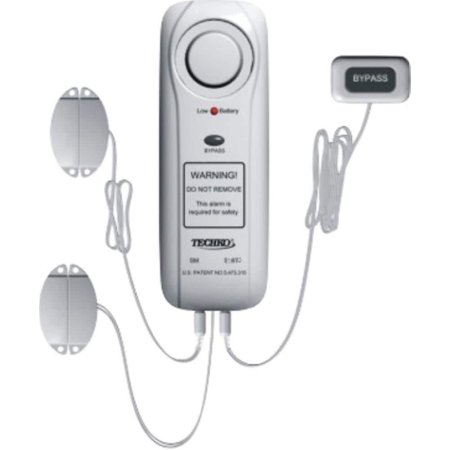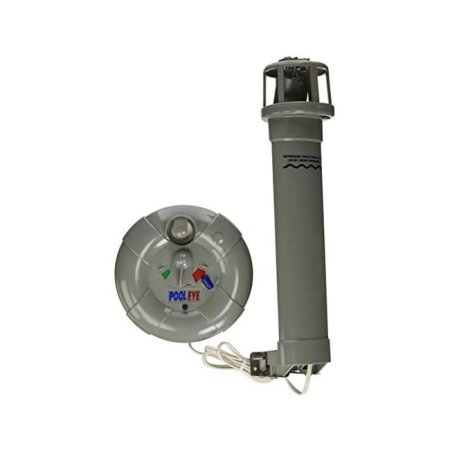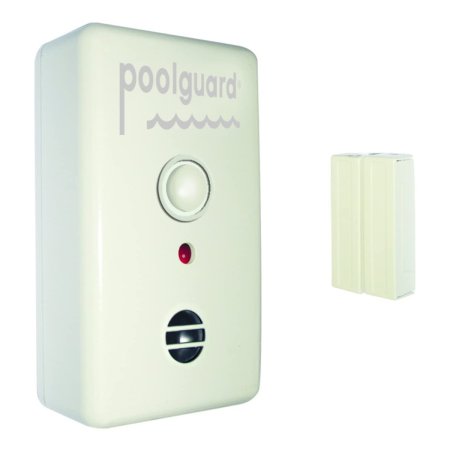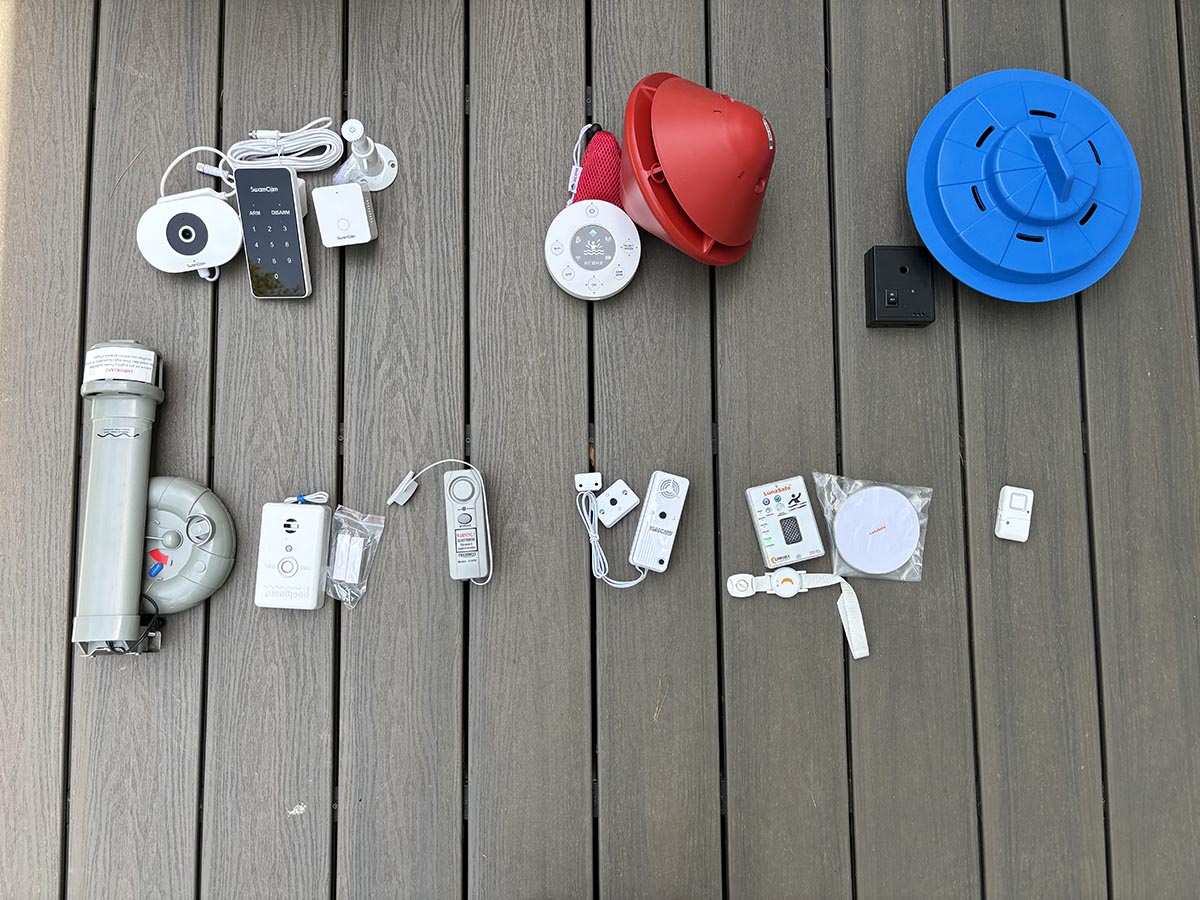
We may earn revenue from the products available on this page and participate in affiliate programs. Learn More ›
For swimming pool owners, especially those with small children or pets, swimming pool alarms that detect motion near swimming pools and notify those nearby of entry are must-have safety devices. These pool alarms, built into larger safety systems, can help improve the overall safety of your pool and yard. In fact, some states require them. We recently researched 20 swimming pool alarms of various sizes, price points, and alarm decibel ranges and then tested the top nine products to determine the best performers.
Based on our testing, our top pick is the Lifebuoy BCone System thanks to its floating capacity, aesthetics, precise detection, and Wi-Fi compatibility. Plus, it works for both inground and above-ground pools, making it a great fit for many different types of pool owners.
Pool alarms should be easy to install, loud enough (with sound measured in decibels) to hear from within the home, and sensitive to motion. Keep reading to learn about the best pool alarms to improve the safety of your swimming pool.
- BEST OVERALL: Lifebuoy BCone System
↓ Jump to Review - BEST BANG FOR THE BUCK: GE Audible Window/Door Alarms
↓ Jump to Review - BEST POOL-ENTRY ALARM: Pool Patrol PA-30 Pool Alarm
↓ Jump to Review - BEST USER-ENTRY ALARM: LunaSafe Pool/Boat Wearable Transmitter
↓ Jump to Review - BEST GATE ALARM: YardGard Pool Gate/Window Alarm
↓ Jump to Review - BEST FOR SLIDING DOORS: Techko Safe Pool Alarm
↓ Jump to Review - BEST FOR ABOVE-GROUND POOL: PoolEye Above-Ground Pool Alarm
↓ Jump to Review - BEST SMART CONTROL: SwamCam Camera Pool Alarm System
↓ Jump to Review - ALSO CONSIDER: Poolguard DAPT-2 Door Alarm
↓ Jump to Review
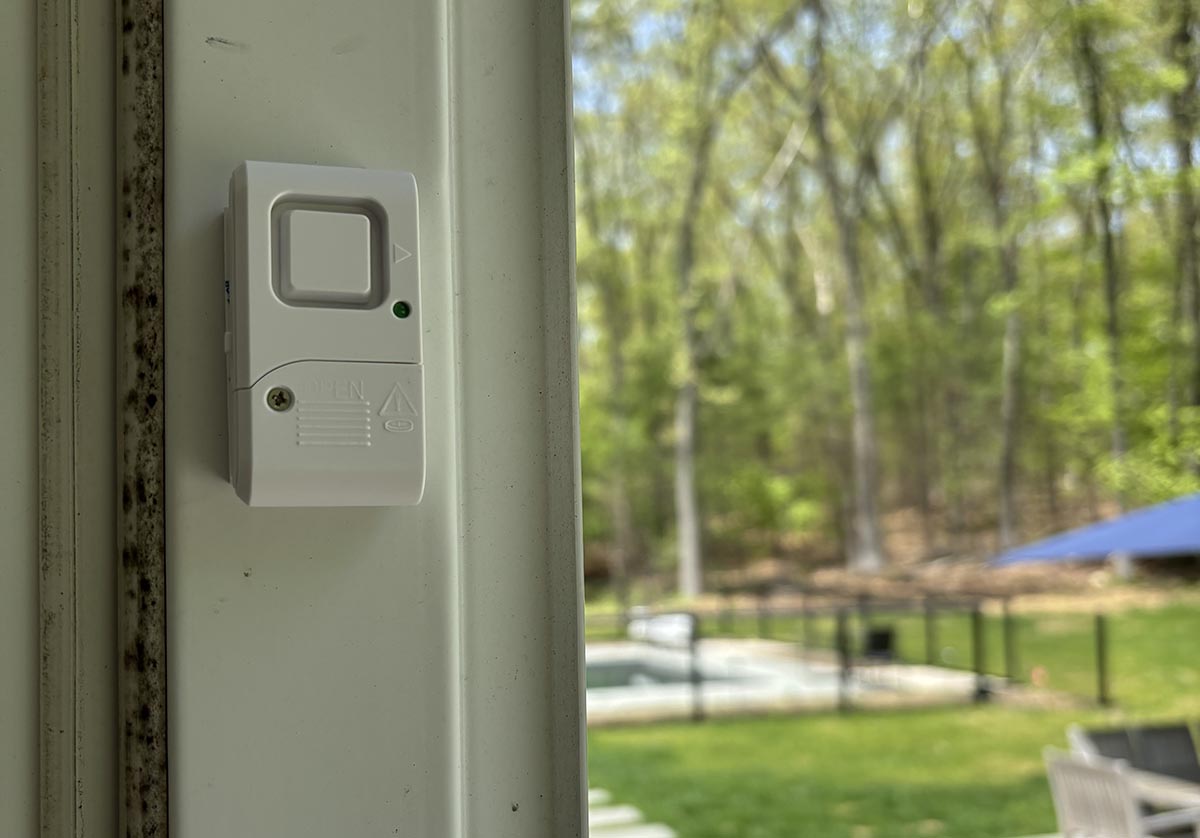
How We Tested the Best Pool Alarms
Since safety is the primary criterion, we prioritized products from reputable brands known for pool safety. We also considered ease of use—a pool alarm is only a benefit if used consistently—so we looked for alarms with a simple design. Finally, we searched for products with adjustable features, such as sensor sensitivity and siren volume.
We researched 20 swimming pool alarms and then tested the top nine products over about 1 week (6 total hours of testing). Using a rubric and specific testing guidelines, we measured sensitivity and range, decibel level, close-range sensitivity, and ease of installation. Then we repeated the sensitivity and range test five times: we discharged each alarm six times, increasing the output and extending the distance from the alarm itself each time. For the two decibel tests, we discharged the alarms first nearby and then farther away, determining how easy it was to hear the alarm at close range and at a distance.
All of these tests allowed us to evaluate how easily the alarm was set off and how easy it was to hear the alarm once it was set off. We awarded points to each pool alarm for how well it performed on the tests using the above-mentioned rubric: the better the performance, the more points we gave. After testing, we averaged the points to determine the top performer, then assigned each of the remaining products a category that best described their strengths.
| Testing Stats | |
| Products tested | 9 |
| Hours/weeks/time spent testing | Approximately 6 hours |
| Tests performed | Sensitivity and range test x 5 Close-range sensitivity and range test x 5 Decibel test Installation test Decibel test in far room of house |
| Price range | $19 to $499 |





Our Top Picks
A reliable pool alarm represents one layer of protection in a swimming pool safety plan. Our top picks can help keep everyone safe and provide peace of mind, especially in homes with children or pets. The best pool alarms featured in this guide are both dependable and easy to use.
Best Overall
Lifebuoy BCone System
Product Specs
- Type: Inground pool-entry alarm
- Maximum pool size: 20 feet by 40 feet
- Decibel level: Not specified
Our Ratings: Installation 4/5; Ease of Use 4.5/5; Effectiveness 4.8/5; Value 4.3/5
What We Like
- Easy-to-use app
- Aesthetically pleasing design
- Detects entry from children and pets, plus has an automatic arming feature for user-friendliness
What We Don’t Like
- Requires a strong Wi-Fi connection
The Lifebuoy BCone System—a floating alarm for pools—is a pool-entry alarm that detects motion within the water. To set it up, users must first connect the BCone to the Wi-Fi and then place the sensor and receiver nearby so the alarm can connect. Then, simply place this floating pool alarm in the water. It works in both inground pools and above-ground pools, where it remains. The alarm volume is adjustable, which is a benefit depending on the distance between the home and pool, or if you are using the pool alarm for kids, in which case more monitoring may be needed.
While testing this pool alarm, we noticed an almost immediate alert when we threw an object into the pool. We repeated this test numerous times and with several different objects, and the alarm responded quickly and loudly with each test. Once the Wi-Fi was enabled, it was also among the easiest alarms to use, and the cherry-red geometric design looked like a pool toy (or buoy, as the company would have it) rather than like a traditional alarm.
Read our full review: Lifebuoy BCone System
Get the Lifebuoy pool alarm at Amazon.
Best Bang for the Buck
GE Audible Window/Door Alarms
Product Specs
- Type: Door/gate alarm
- Maximum pool size: Unlimited
- Decibel level: 120 decibels
Our Ratings: Installation 5/5; Ease of Use 5/5; Effectiveness 4.5/5; Value 4/5
What We Like
- Simple installation; comes with double-sided tape and mounting hardware
- Includes 12 alarms for ample security and peace of mind
- Loud 120-decibel alarm alerts you when a door is opened
What We Don’t Like
- Suitable for indoor use only; not weatherproof
Perimeter detection is one of the most basic components of any pool safety plan. While these affordable GE window/door alarms do not warn against access to the pool itself, you can use them to add extra security to doors and gates around the pool area. These alarms are primarily for indoor use and aren’t weatherproof; however, they may be suitable for well-covered, dry outdoor areas.
Installation is easy via the included double-sided tape. Once installed on a doorway or window, the magnet detector alarms loudly if someone opens the door or window more than ½ inch. Users can choose from a traditional alarm or a chime sound.
These were among the easiest pool safety alarms to install and also among the most affordable of the models we tested. We found they were sensitive to small and large movements, loud enough to hear inside and out, and less visually obtrusive than some of the other gate or door alarms in this guide. In short, these alarms are an excellent budget pick for consumers in the market for pool safety devices.
Get the GE pool alarm at Walmart.
Best Pool-Entry Alarm
Pool Patrol PA-30 Pool Alarm
Product Specs
- Type: Floating pool-entry alarm
- Maximum pool size: 20 feet by 40 feet
- Decibel level: 85+ decibels
Our Ratings: Installation 5/5; Ease of Use 5/5; Effectiveness 4.3/5; Value 3.5/5
What We Like
- Easy and damage-free installation; simply plug in the receiver and place the transmitter in the pool
- 15-pound weight threshold is sensitive enough to detect small waves
- Adjustable detection sensitivity depending upon the individual user’s needs; twist the unit to reduce false alarms
What We Don’t Like
- May not detect gradual entries into the pool
This floating alarm from Pool Patrol is easy to install and features adjustable sensitivity to cater to individual needs. To use, simply place the Pool Patrol PA-30 pool alarm in any pool that measures 20 feet by 40 feet or smaller (and use multiple alarms for larger pools). With a low weight threshold of 15 pounds at its most sensitive setting, this alarm uses a wave-detecting sensor to catch most pool entries.
When a large-enough wave hits the sensor, the onboard alarm goes off and sends a signal to the in-house remote receiver. Both the sensor and the receiver sound a loud alarm (over 85 decibels at 10 feet), and the remote receiver has a 200-foot range to notify adults of an unwanted entry. To reduce false alarms, simply twist the alarm to adjust the sensitivity.
This pool-entry alarm is easy to install. It only took a few minutes to assemble, unlike some of the other models we tested. In testing, we found only two real drawbacks: It’s not the most aesthetically pleasing floating alarm, and it also lacks the sensitivity of the Best Overall pick. During testing, the alarm didn’t detect some of the more-gentle or farther-away motions in the pool. Still, the alarm was loud enough to alert us from inside the home when someone else triggered it.
Get the Pool Patrol pool alarm at Amazon.
Best User-Entry Alarm
LunaSafe Pool/Boat Wearable Transmitter
Product Specs
- Type: User-entry alarm
- Maximum pool size: N/A
- Decibel level: Not specified
Our Ratings: Installation 5/5; Ease of Use 3.5/5; Effectiveness 4/5; Value 3.5/5
What We Like
- Includes a transmitter and a receiver; emits a visual and audio alarm when exposed to water
- Can be worn as a wristband or a clip
- Receiver is easy to install and can be paired with over 25 transmitters
What We Don’t Like
- Must charge receiver occasionally for it to remain operational
- No decibel level listed; some users may not hear when the alarm sounds
For user-entry security, which is a boon for pool owners with children and/or pets on their property, consider the LunaSafe pool/boat wearable transmitter. This system utilizes a locking wristband or clip to attach to a child’s wrist or a dog’s collar that emits an audio and visual alarm to the receiver when exposed to water. Users can pair the receiver alarm with over 25 transmitters, making it ideal for trips to the lake, boating excursions, doggy daycares, and other water-oriented activities beyond one’s own backyard pool.
To set up, simply pair the transmitter with the receiver and attach the transmitter to a child or pet. This unit arrived fully charged, and it was sensitive enough to detect a range of motion during our testing. However, this pool safety alarm is best used in addition to another protective device or additional pool safety equipment (particularly for those with young kids) since it only works if the transmitter is being worn at the time of pool entry.
Get the LunaSafe pool alarm at Lunasea Lighting.
Best Gate Alarm
YardGard Pool Gate/Window Alarm
Product Specs
- Type: Outdoor gate alarm
- Maximum pool size: Unlimited
- Decibel level: 120 decibels
Our Ratings: Installation 3/5; Ease of Use 4/5; Effectiveness 4.5/5; Value 3.8/5
What We Like
- Water-resistant construction is ideal for a variety of outdoor areas
- Easy to install on wood, metal, and other surfaces with included mounting hardware
- Loud 120-decibel siren can be heard from virtually anywhere in a home or yard
What We Don’t Like
- Not as aesthetically pleasing as some comparable options
A weatherproof design and one-touch bypass button make this YardGard gate and window door alarm for pools a good choice for outdoor pool gates. It’s ideal for alarming outdoor gates, doors, and windows thanks to a water-resistant build that withstands the elements.
Mounting hardware is included, and this alarm is easy to install on wooden or metal gates, sliding glass doors, or windows. A one-touch bypass button allows adults to walk by without setting off the alarm. If the system detects unauthorized access, it sounds a 120-decibel alarm to alert nearby adults and neighbors, providing an extra layer of security.
This alarm was the loudest we tested; we could hear it from every room in the house and from all corners of our property when it was engaged. It did take a little while to install, and it was not the most aesthetically pleasing alarm once attached to the sliding door. That said, this is a reliable option for those who are simply looking for traditional swimming pool door alarms that they can hear from anywhere.
Get the YardGard pool alarm at Amazon.
Best for Sliding Doors
Techko Safe Pool Alarm
Product Specs
- Type: Outdoor gate alarm
- Maximum pool size: Unlimited
- Decibel level: 110 decibels
Our Ratings: Installation 3/5; Ease of Use 4.5/5; Effectiveness 4.3/5; Value 4/5
What We Like
- Includes 2 sensors to allow 1 door to remain open; ideal for screened sliding doors
- Weather-resistant construction is well suited for outdoor use, including doors that access pool area
- Comes with mounting hardware for user-friendliness
What We Don’t Like
- System has several wires, which may look messy
Sliding glass or screen doors that access the pool area can be difficult to arm. This is because most door alarms have only one sensor, which users must remove or disable to keep the door open. This weather-resistant door alarm from Techko features two sensors to solve that problem.
Installing the alarm on a screened sliding door is as simple as placing one sensor on the glass door and the other on the screen door. When one of the two doors is closed, the sensor won’t sound, allowing you to leave the screen door closed and the sliding door open. Once installed, this weather-resistant alarm is always monitoring. A bypass button gives adults 8 to 12 seconds to pass through the door without sounding the 110-decibel alarm.
This alarm was not as loud as some of the other gate alarms we tested, However, we could still hear it throughout the home and from our pool area, as well as in our entire yard area when it was engaged. The bypass button is a convenient feature that allows users the benefit of not having to hear an alarm every time they open the door.
Get the Techko pool alarm at Amazon or Lowe’s.
Best for Above-Ground Pool
PoolEye Above-Ground Pool Alarm
Product Specs
- Type: Above-ground pool-entry alarm
- Maximum pool size: 24 feet by 24 feet (round) or 16 feet by 32 feet (oval)
- Decibel level: 85 decibels
Our Ratings: Installation 4/5; Ease of Use 4./5; Effectiveness 4.1/5; Value 4/5
What We Like
- Simple to install in above-ground pools; all mounting hardware included
- Subsurface wave detection notes changes in the water level if the object or person is over 15 pounds
- Adjustable sensitivity to suit an individual user’s preferences; reduces the number of false alarms
What We Don’t Like
- Recommended for above-ground steel-wall pools only
- Lacks remote receiver; may not be ideal for some users
Safety and security measures are not only for inground pools. This PoolEye above-ground pool alarm attaches to the top ledge of steel-wall pools with the included mounting hardware. The water motion sensor reaches under the pool’s surface. It uses subsurface wave detection to catch changes in water level if a person or object over 15 pounds is in the pool, resulting in an 85-decibel alarm sound.
The technology on this PoolEye model allows the alarm to detect intrusions reliably, resulting in fewer false alarms. An adjustable sensitivity switch adds even more reliability. It should be noted that this alarm must be clamped onto the side of an above-ground pool, Since we have an inground pool, we had trouble clamping it securely to the pool’s edge. However, the alarm still engaged when we tested it, even as it floated up toward the surface.
Get the PoolEye pool alarm at Amazon or The Home Depot.
Best Smart Control
SwamCam Camera Pool Alarm System
Product Specs
- Type: Pool-entry alarm
- Maximum pool size: Not specified
- Decibel level: 91 decibels
Our Ratings: Installation 3/5; Ease of Use 3/5; Effectiveness 5/5; Value 4.3/5
What We Like
- Sensitive to both small and large movements
- Has an aesthetically streamlined look
- An optional subscription offers even more features, such as emergency dial
What We Don’t Like
- Installation can take longer than other comparable models
Using advanced AI to detect movement within a certain radius of the pool (a radius that is preprogrammed), the SwamCam is a sophisticated and streamlined option. This is particularly true for users who want a pool alarm that does not interfere with doors, gates, or the pool envelope itself. The wide-angle lens captures the radius of most pools and is a preventive alarm as well, addressing movement both within the water and around the pool’s perimeter. It also has a 911 feature, so users can call emergency services quickly if needed.
We set up the camera on the exterior of our house, about 30 feet from the entrance to the pool, with a clear view of the water. The manufacturer notes that the camera can be up to 100 feet from the pool. When we threw floats and pool toys into the pool, the alarm discharged instantaneously. Once we set it up to establish the so-called danger perimeter (a few feet from the pool envelope), it was also set off by a person approaching the pool. When the alarm went off, we also received a phone notification.
We encountered one drawback. To set up the alarm, we had to program it and connect it to Wi-Fi, which took quite a bit of time. We also had to mount it on the house and plug it in. However, once the setup was complete, we found this pool alarm both easy to use and effective.
Get the SwamCam pool alarm at Amazon.
Also Consider
Poolguard DAPT-2 Door Alarm
Product Specs
- Type: Outdoor gate alarm
- Maximum pool size: Unlimited
- Decibel level: 85 decibels
Our Ratings: Installation 1/5; Ease of Use 3.5/5; Effectiveness 4.5/5; Value 3.3/5
What We Like
- Takes up minimal space on a wall, fence, or pool gate
- Safe for outdoor use; can withstand inclement weather conditions
- Continuous monitoring provides peace of mind in homes with children
What We Don’t Like
- May be too large for door frames and some gates
- Not as attractive as some other pool alarms on the market
The weakest link of any pool area is the gate, which is why this Poolguard alarm is worthy of consideration. After installation on any outdoor or indoor gate, door, or screen, it provides continuous monitoring except for the brief time when an adult activates the pass-through button, as explained below.
If the pool gate is accidentally left open, the alarm sounds an 85-decibel siren after 7 seconds. The delay gives adults time to press the pass-through switch, so the alarm won’t automatically chime as soon as the gate is opened. The delayed siren is designed to prevent false alarms.
This alarm was plenty sensitive, although it is large and will take up space on the door frame or gate. We found the instructions to be needlessly complicated, so the installation took a lot longer than it should have.
Get the Poolguard DAPT-2 pool alarm at Amazon.
Jump to Our Top Picks
What to Consider When Choosing a Pool Alarm
Before buying a pool alarm, check local regulations. In some areas, certain types of pool alarms are mandatory (for example, a gate alarm). Begin by purchasing any mandatory alarms and then add to the system as needed. Use a pool alarm in addition to other layers of protection, such as a fence, a locking gate, a safety cover, and—of course—adult supervision.
Types of Pool Alarms
The best pool alarm for a home depends not only on local regulations but also on the desired safety features and needs. Many homes combine pool alarms to create a fail-safe safety plan. Choose from the following types of pool alarms: standard pool-entry, gate, or user-entry.
Standard Pool-Entry Alarms
Pool-entry alarms, which sense when someone or something enters the pool, contain a surface wave detection sensor that’s triggered when the water is disturbed. These alarms float in the water or attach to the pool’s edge. Floating pool-entry alarms are not permanent; users must lift them in and out of the pool every time.
Poolside alarms, which install on the edge of the pool, contain a sensor arm that extends into the water to sense movement. They can be a permanent or a removable solution. To disable the alarm, some must be lifted from the water, while others have a “swim mode” that pauses the alarm when someone is in the pool. Similarly, you’ll need to reset some alarms after each use, but others automatically switch back on once the water is still.
Some poolside alarms also have infrared motion detection, which operates like a motion-detecting burglar alarm to alert when a person or a pet triggers them.
Gate Alarms
Gate alarms are designed for use with a fenced-in pool perimeter to sound an alert if anyone accesses the pool area. The best pool door alarms can be installed on pool fence gates, sliding glass doors, or windows. These alarms emit a loud sound if someone or something breaches the threshold. However, since door alarms can’t sense if someone actually enters the pool, gate alarms are often used alongside them.
In some municipalities, gate alarms are required by law, so check local bylaws and requirements. Gate alarms also don’t replace a gate lock; instead, it’s essential to use them together.
User-Entry Alarms
User-entry alarms are a wearable alarm system designed for children, pets, or adults who represent a safety risk. These alarms have two parts: a wristband or collar with a sensor and a base station. The sensor portion straps to a person’s wrist or around a pet’s neck and locks with a mechanism that only an adult can open. If the sensor gets wet, the base station sounds the alarm to alert nearby adults. User-entry alarms only protect those wearing a sensor.
Type of Pools
Pool alarms work for inground and/or above-ground pools, depending on the model. Since they don’t install or sit in the water, gate-entry alarms and user-entry alarms are suitable for all pool types. Most floating pool-entry alarms are also suitable for both pool types.
Specific pool-entry alarms can be limited to inground pools or above-ground pools (including quick-set, soft-sided, or portable pools). Read the manufacturer’s recommendations to determine the correct pool type and installation requirements. Installing a pool alarm in a type of pool it’s not designed for may be dangerous and could prevent it from working as expected.
Ease of Use
The best pool alarms are easy to use. When determining ease of use, consider the simplicity of the installation and also how the alarm arms and disarms.
Ease of installation typically depends on the pool alarm type. Floating pool-entry alarms and user-entry alarms are the easiest to install. Permanent pool-entry alarms and gate alarms usually require a few steps to install, but they stay in place for a long time.
Arming and disarming the alarm can also vary depending on the alarm type. For example, you’ll need to remove a floating alarm from the pool, while you must manually switch a gate alarm or a permanent pool-entry alarm on or off. Some pool-entry alarms have a convenient swim mode, which automatically turns on the alarm again after the water is still. The best pool alarms have tamper guards and extra safety features so curious children can’t disable them.
Range
Most pool-entry alarms have a specific sensing range, often determined by the largest recommended pool size. Larger pools may require multiple sensors.
When choosing a pool-entry alarm, consider its weight-sensing threshold. Pool-entry alarms only detect objects over a certain weight, usually starting at around 10 to 20 pounds. This is a critical consideration in homes with small pets or children that weigh less than that range.
Some pool alarms include a remote alarm receiver to plug inside the home that adds an extra layer of safety, setting off the alarm even when no one is near the pool.
Alarm Volume
A pool alarm is only as good as its notification system, and the sound it emits should be loud enough to notify someone inside the house. Even louder versions can notify neighbors.
The chime on the average alarm clock is about 70 to 80 decibels, and a pool alarm should reach the same decibel level or even higher.
For remote receiver alarms, 80 or more decibels is suitable. Look for even louder options for models without a remote receiver because someone inside the home must hear the outdoor pool alarm. Most pool alarms also list the decibel rating in relation to distance.
Smart Control
A smart pool alarm, which connects via Wi-Fi or Bluetooth, allows you to control, monitor, or receive notifications through a smartphone. Smart control is most commonly provided for perimeter alarms like gate or doorway alarms, which often connect to a home security system.
Very few pool-entry alarms have smart controls. They usually connect to a smartphone for simple tasks, such as monitoring battery levels or setting various functions.
FAQs
For pool owners, pool safety is of the utmost importance. A pool alarm plays one part in preventing dangerous pool-related accidents, keeping your household safer and providing peace of mind. Ahead are some frequently asked questions along with their answers to help you install and use your new pool alarm.
Pool alarms can increase a pool’s safety, but they are not a replacement for other safety measures, such as adult supervision, gate alarms, and general safe swimming practices.
Installation location depends on the pool alarm type, so follow the manufacturer’s directions. However, most pool alarms should be placed where adults, children, pets, and wildlife could enter the pool or the pool area, quickly detecting anything or anyone who could fall in.
Most pool alarms can be installed by the owner. Many installations don’t require tools and come with mounting hardware that most DIYers or first timers can install themselves.
In some areas, laws mandate fencing and gate alarms around residential pools. Check your local laws to determine if these rules apply to your home. No matter the laws, those with children and/or pets will want to consider having a fence around their pool for added safety and peace of mind.
Most pool alarms don’t have cameras. Users who want added security might want to install a security camera alongside their pool alarm to have eyes and ears on the pool.
A pool alarm detects unwanted access to the pool, whether it’s a perimeter breach, water displacement, or water contact, and sounds an alarm to notify you of a possible hazard.
Meet the Tester
Hannah Selinger is a James Beard Award–nominated writer with work appearing in The New York Times, Travel + Leisure, The Boston Globe, The Washington Post, and elsewhere. Hannah has completed seven home renovations since 2017 and currently lives in Boxford, Massachusetts, with her husband, two sons, two dogs, Russian tortoise, and an inground pool, which she has maintained for 8 years.
Additional research provided by Jasmine Harding.
